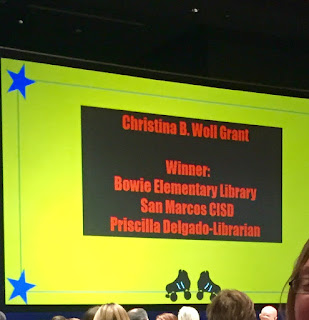by
Priscilla Delgado, Bowie Elementary, San Marcos Consolidated ISD; TALL
Texans Class of 2016, Teacher Day @ TLA Task Force, Tejas Star Reading List
committee, Tomas Rivera Book Award Committee.
Once
upon a time, I was a new librarian with a healthy book budget. I was able to purchase new titles and award-winning
books without thinking twice about it. I
also had enough money to bring authors to our school and purchase books and
prizes to give away to our students. It
was a blissful time.
Sadly,
those good old days are gone. As many of us in public schools have experienced,
there are budget cuts left and right, reducing or completely eliminating
funding for various programs, resources and activities. I found myself working with less money year
after year, until ultimately I came to a point that I could no longer afford to
purchase the books and materials my students were accustomed to having.
To
make matters more challenging, our school district was experiencing a budget
deficit, and for the 2016-17 school year, my budget was one-fifth of what it
had been previously. This was a major
blow, and I longed for the days that I could freely and happily purchase what
my students and teachers wanted and needed.
Working with a fraction of what I once had, I had to drastically reduce
the number of books I could purchase, and in turn, modify one of our library
celebrations.
Every
spring, we study the ALA award winning titles as part of a library unit -
Caldecott, Newbery, Coretta Scott King, and Pura Belpré. Unfortunately, for the
2016-17 school year, I was unable to purchase the award winners. Due to the budget constraints, the one-fifth
budget that I had was already earmarked for other materials the school
needed. Anticipating the lack of funds
to purchase the ALA winners, I created a Donors Choose project in September
2016, hoping to raise enough money to purchase the ALA winners, but it was not funded
within the time frame, much to my disappointment.
I
received an email about the Christina B. Woll Memorial Fund Grant through one
of the library listservs, and initially I didn’t feel the urge to apply. I had applied in the past, and hadn’t been
selected. The Woll Grant had come to
feel to me like Charlie Brown and the football - something elusive and just out
of my reach. But did Charlie Brown ever
give up on kicking the football? He kept
trying! I figured that I had as good a
shot as anyone and it wouldn’t hurt to apply again, so I moved forward with the
application. I shared with my
administrators that I was applying for this grant and what I hoped to use the
money for if it was awarded, and stressed the fact that I had an insufficient
budget to purchase the library materials that I needed for our students and for
my curriculum.
Lo
and behold, one day in March 2017, I received a phone call from the Woll Grant
committee chair. My library had been
selected for the Christina B. Woll Memorial Fund Grant!!! I shared the news with my administrators, my
family and friends. I felt excited and
triumphant; my inner Charlie Brown had finally kicked that football.
The
grant allowed me to purchase the ALA winners, and I have enough money to
purchase the award winners for 2018 as well.
I was honored to be recognized during the Texas Bluebonnet Award
luncheon as the Woll Grant recipient for 2017.
At the beginning of the 2017-18 school year, to my delight, I was given
a much larger budget, similar to what I used to receive, specifically to
enhance our suffering library collection.
It makes my heart
happy to know that we will be able to improve the library's holdings to best
serve our students and teachers.
So,
even though I’ve had my budget challenges and I anticipate there may be more in
the future, it felt like a fairy tale ending to receive the Woll Grant. If you find yourself in a similar situation,
in which your library budget is not sufficient for what you need or want,
consider applying for this grant. It
targets libraries who demonstrate a commitment to providing quality children’s
literature and a need to enhance an area of their collection or
programming. I’m thankful to the Woll
Grant for selecting my school for the grant, and to TASL Talks for the opportunity
to share my story with you. For more
information, visit the Woll grant website.
The deadline for the grant is January 31, 2018 -- good luck to all the
applicants!
NOTE: Many TLA and TASL awards have applications and/or nominations that open in December and January. Scholarships as well. Check out the opportunities!
NOTE: Many TLA and TASL awards have applications and/or nominations that open in December and January. Scholarships as well. Check out the opportunities!
























